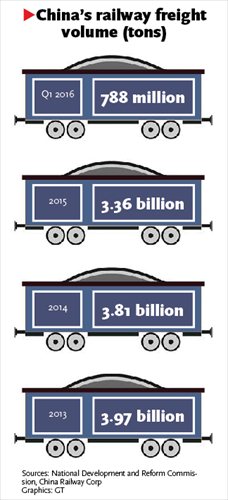
Passenger traffic booms as labor moves around nation
Railway freight volume slid in the first quarter, according to a media report, and experts said the fall shows the intense pressure bearing down on traditional industries in China.
Cargo movements by rail fell 9.43 percent year-on-year to 788 million tons in the first three months of 2016, domestic news portal caixin.com reported Monday, citing the latest data from China Railway Corp (CRC).
Shipments by rail have been falling since CRC was established in 2012, the report said. The company was formerly part of the now defunct Ministry of Railways.
Rail cargo volume in 2015 decreased 11.9 percent year-on-year to 3.36 billion tons, the largest slump ever, data from CRC showed.
At the current rate, rail freight volume seems headed back down to that of 2009, when it was just 3.32 billion tons, the caixin.com report said, unless CRC can turn things around.
In 2009, the world economy was mired in the global financial crisis.
"The continuous drop in railway freight volume indicates persistent downward pressure in secondary industry, especially in sectors that are experiencing severe overcapacity like steel and coal," Liu Xuezhi, a senior analyst at Bank of Communications, told the Global Times Monday.
Liu pointed out that such industries traditionally contributed a large portion of railway freight volume growth.
Despite the tough conditions, the National Railway Administration (NRA) still holds a positive view about achieving the targets for rail freight during the 13th Five-Year Plan period (2016-20).
National railway freight volume is expected to reach 4.2 billion tons at the end of 2020 with annual average growth of 4.3 percent, caixin.com said, citing data from the NRA.
It won't be easy to achieve that growth target, considering the sluggish industrial sector, according to Liu.
"But looking ahead, the economy may recover further and the growth rate of rail freight may also pick up," he said.
Railway freight volume used to be considered a major gauge of China's economic health, but as the nation's economy undergoes a structural transformation, the indicator is losing relevance, Liu noted.
"For instance, growth in railway freight volume doesn't say anything about the development of the services sector," he said.
Dong Dengxin, a finance researcher at the Wuhan University of Science and Technology, agreed.
The slump in railway freight shows how the "old economy" such as manufacturing and chemical companies is being supplanted by emerging industries like technology and services, Dong said.
China's GDP growth slowed to 6.8 percent in the fourth quarter of 2015, and experts from the Bank of Communications have estimated that GDP growth was about 6.8 percent in the first quarter of this year, despite the sharp drop in railway freight volume.
In sharp contrast to the waning fortunes of rail cargo, passenger transport has been booming. Passenger volume approached 668 million trips in the first quarter of 2016, up 13.7 percent year-on-year, caixin.com said.
Rising ridership demonstrates that labor is flowing smoothly around the nation, which is a good sign and a reflection of China's socioeconomic structural transition, Dong told the Global Times on Monday.


















































